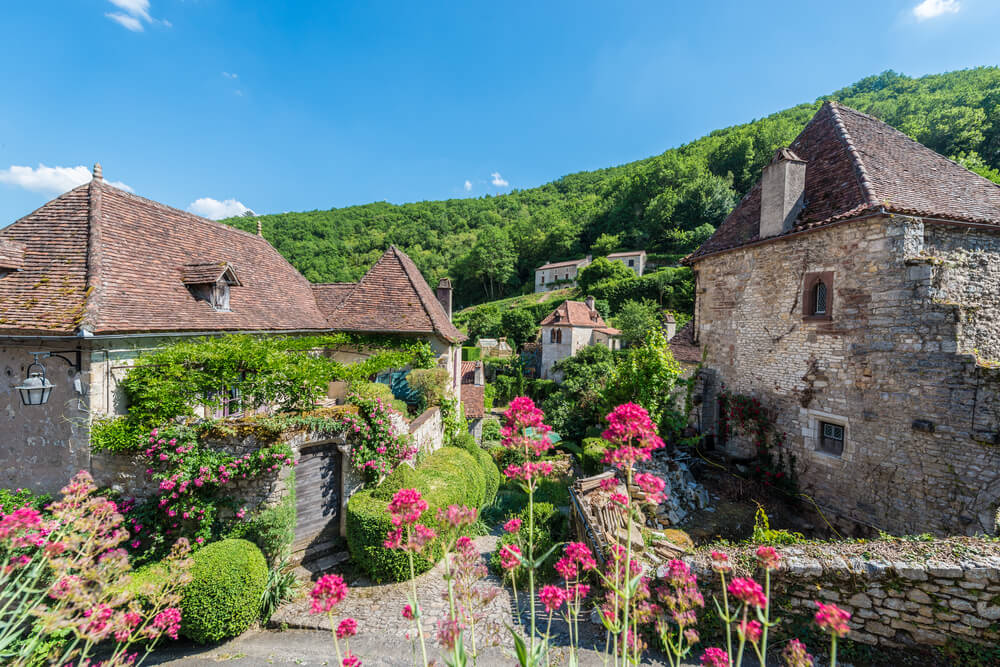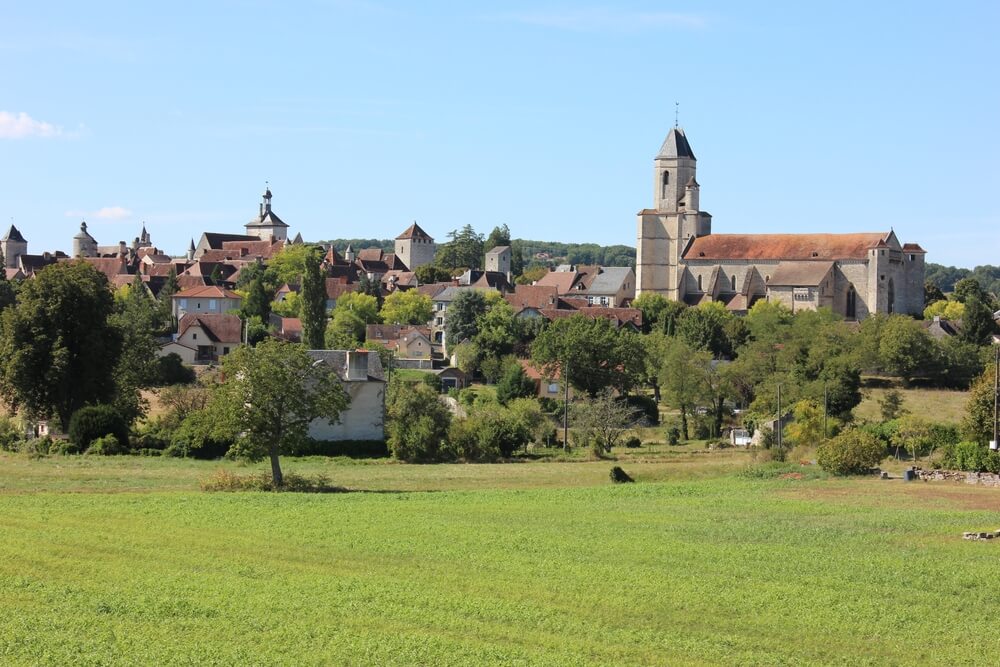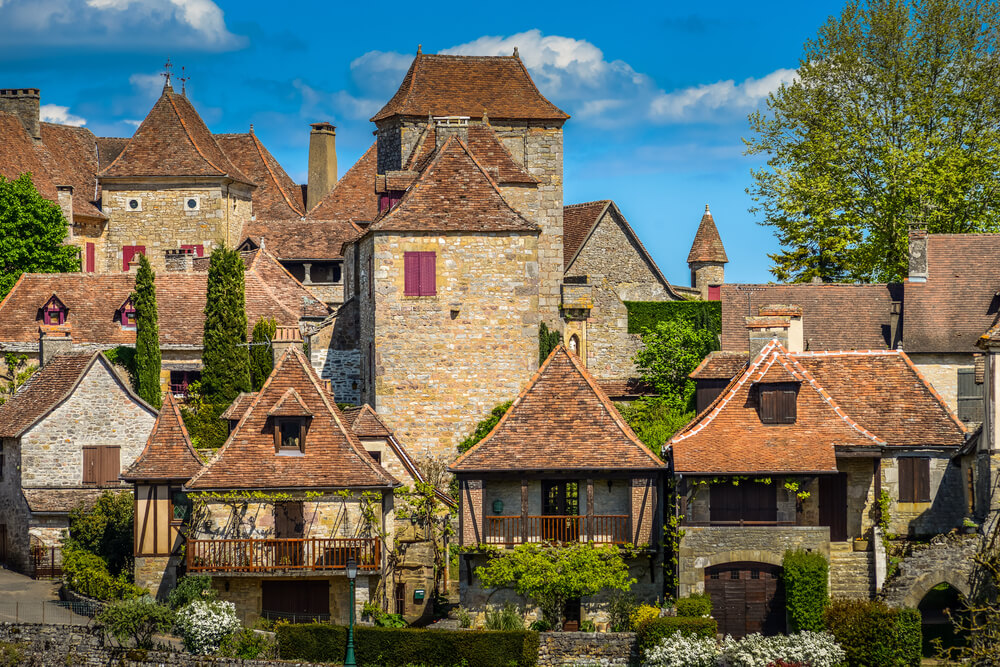Lot: 4 of the most beautiful villages in France

Set in the tranquil hollow of the Dordogne valley, discover the four idyllic villages of Martel, Autoire, Loubressac and Carennac. Located just 15 minutes from each other, these four villages have been awarded the title of “Most Beautiful Villages in France”.
So what’s so special about them that they deserve such a title? Let’s discover the secrets of these exceptional villages.
First of all, let’s go back to the origins. Created in 1982, the label’s mission is to showcase the most charming villages in France. The famous “Most Beautiful Villages in France” must meet a number of criteria, including
- A population of less than 2,000
- A rich cultural heritage
- Two or more sites listed as historic monuments.
The headquarters of the association has remained unchanged since its creation. It is located in Collonges-la-Rouge in the Corrèze.
Back to the Lot, where there seems to be a greater concentration of charming villages than elsewhere. In all, not 4 but 6 villages in the department feature on the list! The winning quartet nestle in the Dordogne valley, and each of the villages is recognisable by its ochre stonework, deep dark tiled roofs and intricately carved windows.
Magnificent as they are, these villages are miniature oases, enough to be visited ‘with one stone’.
Bear in mind that many of the other villages in the area are also worth a visit. We recommend a chance visit along country roads and steep gorges, to flush them out one by one. However, it is the villages of Martel, Carennac, Loubressac and Autoire that have been the focus of attention since they were awarded the famous “Most Beautiful Villages in France” label!
Martel, the medieval town with 7 towers
Rumour has it that this picturesque village owes its name to Charles Martel, the Frankish military leader and hero of the Battle of Poitiers in 732. However, the truth is quite different. The village actually takes its name from the eponymous limestone terrain on which it is built.
Martel was born at the crossroads of the North-South and West-East routes, through which goods such as salts from the Atlantic and wines from Aquitaine passed. The village was an essential crossroads for trade, enriched by the cloth trade.
On a more pious note, Martel was also a major stopover on the Rocamadour pilgrimage.
With such a melting pot of wealth and population, the town needed to protect itself even more. To this end, the inhabitants built an enclosure crowned with seven towers around Martel. Five of these towers were used as watchtowers and two others were dedicated to worship. Note the imposing fortified church, vigorously defended by a keep with watchtower, machicolation and bell tower. It is set against the ramparts and is over 40 metres high.
Here and there in Martel, the remains of a lively, fortunate and tumultuous past are wonderfully well preserved and scattered. The covered market in the Place des Consuls, with its 18th-century chestnut framework, is a proud example. Today, this market hall continues to keep the town’s trading traditions alive, hosting markets twice a week.
An air of Versailles in Autoire
This village is a little corner of paradise nestling in the heart of a white limestone cirque. Only the thick vegetation contrasts with the intense white of the cliffs.
The immaculate stone houses are arranged in staggered rows. They form a cascade of brown tiles, with square dovecotes, old barns in purplish hues and beautiful half-timbered houses, most of which date from the 16th century.
The town owes its nickname of “Little Versailles” to its old manor houses and châteaux.
In Autoire, all the streets converge towards the centre. Take a leisurely stroll along the lushly flower-filled streets until you reach the Place de la Fontaine. From here, you can see the Château des Anglais, a former brigands’ hideout carved out of the cliff.
Continue on in search of fresh air. Take the Chemin du Paradou until you reach the cascade: the highest waterfall in the département (30m).
Presque, its caves and its wine
The tour of the Lot’s exceptional villages continues as far as Saint-Médard-de-Presque and its Presque caves.
From here, you’ll have to descend 90 metres underground to discover a cathedral of concretions. Such a natural miracle can only be shaped by time and the elements.
Admire the majestic pillars of crystallisation, up to 10 metres high. A veritable museum of eccentric shapes and a multitude of colours can be seen down here. These oddities of nature are highlighted by lighting made up of several hundred lamps.
This geological treasure trove was discovered at the beginning of the 20th century, purely by chance on a building site. It was then developed by the ancestor of Maurice Lamouroux, the site’s current owner and guide/lecturer.
In the meantime, he also developed a passion for oenology. The caves were given a new function, that of wine cellar. The owner stores and sells hundreds of bottles of Coteaux-de-glanes on site!
Loubressac, leading the way
Firmly perched on its rocky outcrop, Loubressac dominates the Dordogne valley and vies with the town of Autoire for the title of “Little Versailles”. The village offers locals and visitors alike breathtaking views over the Dordogne valleys and the castles of Castelnau-Bretenoux, Montal and Saint-Laurent-les-Tours.
You’ll enter the village through a town gate and wend your way through the medieval streets, lined with ochre stone mansions topped with pointed roofs. As well as the charming setting, the church of Saint Jean-Baptiste and the colossal manor houses will round off your discovery of the village in style.
The medieval setting of Carennac
To reach the medieval town of Carennac, you have to follow the Dordogne valley through the centre of the Pays d’Art et d’Histoire.
Carennac is a Cluniac site. The congregation established a priory in the village, which became a deanery in the 13th century. After the tragedies of the religious wars and the Hundred Years’ War, the deanery passed into the hands of the Salignac de La Mothe-Fénelon family. Fénelon himself ran the deanery and later became Archbishop of Cambrai. It was during this period that he is said to have written “The Adventures of Telemachus”.
To take a trip back in time, all you have to do is cross the town bridge. Look out for the roofs of all shapes, towers, turrets and carved windows characteristic of the period. The Cluniac castle is a striking reminder of Carennac’s rich past.
Built in the 16th century to house the deans, the château is Renaissance in style. The sculpted dormer windows and corner turrets are particularly striking. Don’t miss the sumptuous painted ceiling in the ceremonial hall.
Today, the château houses the Centre d’interprétation de l’architecture des pays d’Art et d’Histoire. Nearby, you can walk through the priory walls to the church of Saint-Pierre. Originally built in the 11th century, the church was enlarged the following century.
In the porch, you’ll see Christ surrounded by the symbols of the four evangelists and the apostles. Note the refined details of the alabaster statue of the Virgin and Child.
The tsunami of the Hundred Years’ War left only one gallery as a vestige of the Romanesque cloister. The other three were rebuilt in the flamboyant Gothic style typical of the 15th century. Take a look inside and you’ll see an admirable tomb made of local stone. Carennac stone used to be polychrome! The work is completed by a group of statues of saints made by the same artists. Religious creation is a symbol of justice.
200 audioguided tours for cities all around the world
Download



